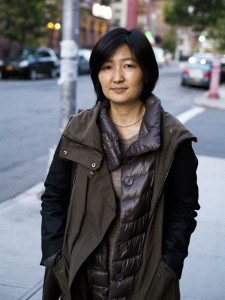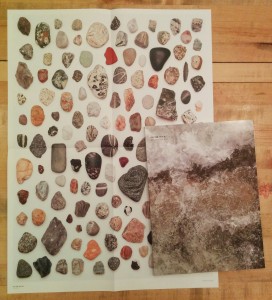Does Spring Come to Stolen Fields fairly brims with nuanced intent. It is a book with a mission.
The photographs in Does Spring Come to Stolen Fields are, for the most part, lyrical pastoral scenes taken in Fukushima and its surrounds in the year after the 2011 earthquake and tsunami. There is a quiet that descends over the mostly depopulated scenes. In much the same way that the poem from which this book takes its title is a poem of protest only in its opening and closing lines, it is only in the foreword and afterword that this book makes its clearest protests. The photographs may be at once beautiful and unsettling, but they are indirect. It is only through the thoughtful polemics by Han Hong-koo and Suh Kyung-sik that the full weight of their protestation becomes evident.
Two photographs in particular bring the book’s main theme into clear focus: In the first, a persimmon tree dominates the foreground with an orchard spreading out behind it. Dozens of ripe fruits hang heavy on the tree. In the background, dozens, perhaps hundreds, of equally ripe fruits await a harvest that will never come. The midday sun of everyday, any day, highlights the tree’s tangle of branches and the carpet of unmown grass below it. In the second, a ruffled beach recedes into the distance. Round stones and bits of small debris litter the sand. Two hardscrabble pine trees stand resolutely in the center of the frame. Waves roll in without end from the left. An empty, low and brown field extends from the trees right out to the background. In the far distance, straight out the shoreline, sit the boxy shapes familiar from newscasts of the Fukishima disaster.
What future do these lands have? Even as the disaster recedes into the past, its effects remain present. The news cameras may have moved on but despite significant clean up efforts the fallout of the disaster will not disappear any time soon.
In his afterword, Suh Kyung-sik recounts a young farmer stopping the group that he and the photographer were traveling with to berate them for coming to make their pictures but not doing anything to help the people who have been most directly affected. This highlights a central problem with a book like this: It’s impact will likely be limited. However good a photographer’s intentions, however strong the photographs, however horrific their subject it is difficult for photographs alone to move people to create change. Photographers have been showing us in detail the horror of war for a century and a half and yet we’re no closer to ending war.
Chung counters this problem in two ways. This book is not a one off exercise. It is part of the photographer’s ongoing interest in and concern with the peace movement’s opposition to the nuclear industry. Chung has previously published two books on the topic of nuclear power. His earlier publications were meant to show the insidious threat that we have become complacently inured to. Does Spring Come to Stolen Fields is a tragic extension of these earlier projects. More importantly, Chung partners with others working in the peace and non-proliferation movements. His photographs and books are meant to be bricks in a larger struggle.
And, struggle or protest is exactly what these photographs are. The book’s title is drawn from the poem Does Spring Come to Stolen Fields that was published in 1926 by Lee Sang-hwa. The poem led to the shuttering of the magazine Gaebyeok in which it was first published and in Lee’s arrest for anti-Japanese activities. The poem was an absolutely anti-colonial protest against the Japanese occupation.
At first glance, a Korean poem protesting the Japanese occupation of Korea a century earlier might seem an odd or even errant choice as a primary reference point for a book calling attention to the fallout from a present day natural disaster in Japan. Han and Suh both take pains to elucidate how the reference is both valid and useful. Suh in particular teases out interesting inferences from the comparison.
By TEPCO and the Japanese government’s estimates, it will take decades for the Fukushima Daiichi reactors to be fully shut down. Radiation will be a problem for decades longer, if not centuries. The fallout from this disaster will long reverberate–much as the fallout from the Japanese occupation of Korea has reverberated in national politics and personal histories for the last 100 years. In this mirroring of long-term fallout, Suh sees the seeds of dialogue towards the finding of common ground.
Lee’s poem was a protest against the occupation–in particular the theft of Korean lands in the name of increased productivity. The Fukushima disaster might not be a colonial occupation, but it presents a situation in which the national government in cahoots with powerful industrial lobbies has stolen peoples’ lands. There is right and there is wrong. When wrongs are perpetrated against the people, the powerful, whether working through the guise of a foreign or domestic government, must be held accountable to the people.
Accountability is a tricky endeavor, however. Chung, Han and Suh are all aligned against the nuclear industry and its supporters in government. The nuclear industry goes back to World War II. In this way the Japanese become the first victims of the nuclear industry–as well as the perpetrators of gross human rights violations throughout Asia. Han and Suh both point out that the deaths of hundreds of thousands in Nagasaki and Hiroshima do not excuse the country for its brutal actions that led to the deaths of millions throughout Asia. Conversely, the wrongs perpetrated against Korea during the occupation do not allow Koreans to wash their hands of what has happened at Fukushima and to ignore the present day victims of this present nuclear disaster. However fraught a relationship might be, a natural/nuclear disaster cannot in good conscience be read as retribution, though nor should it absolve a country of past wrongs or obviate the need for apology.
(As a side note: the intended audience for this book is primarily domestic, i.e. Korean. When I write that Koreans cannot wash their hands of what has happened at Fukushima, it would be equally fair to read that as “the international community cannot wash its hands of the disaster.” This is a disaster for all humanity. Likewise, the threat and opportunity of nuclear energy is a something that must be considered by all humanity.)
All of this cannot be communicated by the photographs alone. Chung’s photographs show the landscapes stolen by the disaster: fields that can no longer be tilled, orchards that cannot be harvested, homes that cannot be lived in, highways that cannot be followed and beaches that cannot be enjoyed. Nature herself continues on. Weeds poke through the pavement of a bridge. Birds wheel overhead. Flowers erupt from beneath frost. The ocean rolls and rolls and rolls onto the beach.
In one photograph of a nursing home interior, the high water line reaches nearly to the clock mounted high on the wall. The paint above the line is clean, except where water has splashed. Below, the wall is a fractal mess of dried mud, and the floor is coated in silt left by the receding water. Suh relates his experience of seeing this photograph for the first time and of Chung relating that the clock continued to run as if nothing had happened. This building can no longer accommodate human activity and yet time has gone on. The clock continues to run. Even once its battery gives out, time will still flow.
Spring will come to the fields in Chung’s photographs, but it will matter little to those from whom they’ve been stolen.
Does Spring Come to Stolen Fields
Chung Ju-ha
Essays: Han Hong-koo and Suh Suh Kyung-sik
Published by Noonbit Publishing Co.
2012
 On October 26th, Sangyon Joo of Datz Press came by KPB HQ to talk about her experiences as a publisher, curator and photographer. We’d first met during Printed Matter’s Art Book Fair at PS1 when I stopped by the Datz Press booth. This conversation has been edited for length and clarity.
On October 26th, Sangyon Joo of Datz Press came by KPB HQ to talk about her experiences as a publisher, curator and photographer. We’d first met during Printed Matter’s Art Book Fair at PS1 when I stopped by the Datz Press booth. This conversation has been edited for length and clarity.  Let’s start with the conclusion: Kyoungtae Kim’s On the Rocks is an amusing, clever and honest book but not a grand one. That conclusion can be drawn from its subject matter: close-up macro photographs of small, everyday stones–roughly 2cm to 10cm in length. The bulk of the book is single pages in which each stone, floating in studio limbo, is enlarged to fill the page. Every singular stone is richly textured, wonderfully abstract and evocative–and yet humdrum.
Let’s start with the conclusion: Kyoungtae Kim’s On the Rocks is an amusing, clever and honest book but not a grand one. That conclusion can be drawn from its subject matter: close-up macro photographs of small, everyday stones–roughly 2cm to 10cm in length. The bulk of the book is single pages in which each stone, floating in studio limbo, is enlarged to fill the page. Every singular stone is richly textured, wonderfully abstract and evocative–and yet humdrum. Those three facts make me think the book came out of two questions: 1. When I travel to Europe, what can I bring back with me? 2. Now that I’ve got all these stones and pebbles sitting around, what can I do with them?
Those three facts make me think the book came out of two questions: 1. When I travel to Europe, what can I bring back with me? 2. Now that I’ve got all these stones and pebbles sitting around, what can I do with them? The photographs are also placed in grids in which the stones are seen relative to one another. On the inside covers, the stones are scaled to a single uniform size and printed in grids. In a nice touch, one must open the inside flap of the cover (onto which the full bleed cover image does not extend) to reveal the grids. A similar gridded spread follows the colophon page; on this grid the stones are scaled relative to one another and there is a scale so that one can determine how large each stone is in reality. This grid is repeated on a pull out poster on which the stones are printed life size (at 1:1 scale).
The photographs are also placed in grids in which the stones are seen relative to one another. On the inside covers, the stones are scaled to a single uniform size and printed in grids. In a nice touch, one must open the inside flap of the cover (onto which the full bleed cover image does not extend) to reveal the grids. A similar gridded spread follows the colophon page; on this grid the stones are scaled relative to one another and there is a scale so that one can determine how large each stone is in reality. This grid is repeated on a pull out poster on which the stones are printed life size (at 1:1 scale).
 There is one outlier image. At the top of the colophon page is a photograph of two rocks sitting heavily on a paved street. These are
There is one outlier image. At the top of the colophon page is a photograph of two rocks sitting heavily on a paved street. These are 

